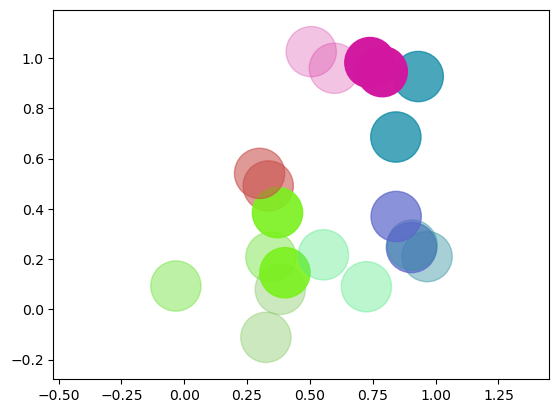4. Functions and Classes#
Let us learn how to define your own functions, and further organize them into a class for neatness and extensibility.
References
Python Tutorial (https://docs.python.org/3/tutorial/)
Section 4.7-4.8: Functions
Chapter 6: Modules
Chapter 9: Classes
import numpy as np
import matplotlib.pyplot as plt
%matplotlib inline
Defining functions#
If you find yourself running the same codes again and again with different inputs, it is time to define them as a function.
Here is a simple example:
def square(x):
"""Compute x*x"""
# result returned
return x*x
square(3)
9
a = np.array([1, 2, 3])
# input `x` can be anything for which `x*x` is valid
square(a)
array([1, 4, 9])
The line encosed by “”” “”” is called a Docstring, which is shown by help( ) command.
help(square)
Help on function square in module __main__:
square(x)
Compute x*x
square?
A function does not need to return anything.
def print_square(x):
"""Print x*x"""
print(x*x)
# the end of indentation is the end of definition
print_square(a)
[1 4 9]
A function can return multiple values.
def square_cube(x):
"""Compute x**2 and x**3"""
# return multiple values separated by comma
return x**2, x**3
# results can be assigned to variables separated by comma
b, c = square_cube(a)
print(b, c)
[1 4 9] [ 1 8 27]
square_cube(3)
(9, 27)
Arguments and local variables#
A function can take single, multiple, or no arguments (inputs).
An argument can be required, or optional with a default value.
An argument can be specified by the position, or a keyword.
def norm(x, p=2):
"""Give the L^p norm of a vector."""
y = abs(x) ** p
return np.sum(y) ** (1/p)
a = np.array([1, 2, -2])
norm(a) # default p=2
np.float64(3.0)
norm(a, 1) # specify by position
np.float64(5.0)
norm(p=1, x=a) # specify by the keywords, in any oder
np.float64(5.0)
Local and global variables#
Arguments and variables assigned in a function are registered in a local namespace.
y = 0 # global variable
norm(a) # this uses `y` as local variable, y=[1, 4, 9]
print(y) # the global variable `y` is not affected
0
Any global variables can be referenced within a function.
a = 1 # global variable
def add_a(x):
"""Add x and a."""
return a + x
print(add_a(1)) # 1 + 1
a = 2
print(add_a(1)) # 1 + 2
2
3
To modify a global variable from inside a function, it have to be declaired as global.
a = 1
def addto_a(x):
"""Add x into a."""
global a
a = a + x # add x to a
addto_a(1) # a = a + 1
print(a)
addto_a(1) # a = a + 1
print(a)
2
3
You can modify an argument in a function.
def double(x):
"""Double x"""
x = 2 * x
return x
double(1)
2
Script#
Before Jupyter (iPython) notebook was created, to reuse any code, you had to store it in a text file, with .py extension by convention. This is called a script.
This magic command creates a simple script file.
%%file hello.py
print('Hello!')
Overwriting hello.py
%cat hello.py
print('Hello!')
The standard way of running a script is to type in a terminal:
$ python hello.py
In a Jupyter notebook, you can use %run magic command.
%run hello.py
Hello!
You can edit a python script by any text editor.
In Jupyter notebook’s Files window, you can make a new script as a Text file by New menu, or edit an existing script by clicking the file name.
Module#
A script with function definitions is called a module.
%%file lpnorm.py
"""L^p norm module"""
import numpy as np
def norm(x, p=2):
"""The L^p norm of a vector."""
y = abs(x) ** p
return np.sum(y) ** (1/p)
def normalize(x, p=2):
"""L^p normalization"""
return x/norm(x, p)
Overwriting lpnorm.py
%cat lpnorm.py
"""L^p norm module"""
import numpy as np
def norm(x, p=2):
"""The L^p norm of a vector."""
y = abs(x) ** p
return np.sum(y) ** (1/p)
def normalize(x, p=2):
"""L^p normalization"""
return x/norm(x, p)
You can import a module and use its function by module.function().
import lpnorm
help(lpnorm)
Help on module lpnorm:
NAME
lpnorm - L^p norm module
FUNCTIONS
norm(x, p=2)
The L^p norm of a vector.
normalize(x, p=2)
L^p normalization
FILE
/Users/doya/OIST Dropbox/kenji doya/Python/iSciComp/lpnorm.py
a = np.array([-3, 4])
lpnorm.norm(a)
np.float64(5.0)
lpnorm.norm(a,1)
np.float64(7.0)
lpnorm.normalize(a)
array([-0.6, 0.8])
Caution: Python reads in a module only upon the first import, as popular modules like numpy are imported in many modules. If you modify your module, you need to restart your kernel or call importlib.reload().
import importlib
importlib.reload(lpnorm)
<module 'lpnorm' from '/Users/doya/OIST Dropbox/kenji doya/Python/iSciComp/lpnorm.py'>
Package#
A collection of modules are put in a directory as a package.
# see how numpy is organized
%ls $CONDA_PREFIX/lib/python*/site-packages/numpy
__config__.py _pyinstaller/ lib/
__config__.pyi _pytesttester.py linalg/
__init__.cython-30.pxd _pytesttester.pyi ma/
__init__.pxd _typing/ matlib.py
__init__.py _utils/ matlib.pyi
__init__.pyi char/ matrixlib/
__pycache__/ compat/ polynomial/
_array_api_info.py conftest.py py.typed
_array_api_info.pyi core/ random/
_configtool.py ctypeslib.py rec/
_configtool.pyi ctypeslib.pyi strings/
_core/ doc/ testing/
_distributor_init.py dtypes.py tests/
_distributor_init.pyi dtypes.pyi typing/
_expired_attrs_2_0.py exceptions.py version.py
_expired_attrs_2_0.pyi exceptions.pyi version.pyi
_globals.py f2py/
_globals.pyi fft/
Object Oriented Programming#
Object Oriented Programming has been advocated since 1980’s in order to avoid naming conflicts and to allow incremental software development by promoting modularity.
Examples are: SmallTalk, Objective C, C++, Java,… and Python!
Major features of OOP is:
define data structure and functions together as a Class
an instance of a class is created as an object
the data (attributes) and functions (methods) are referenced as
instance.attributeandinstance.method().a new class can be created as a subclass of existing classes to inherit their attributes and methods.
Defining a basic class#
Definition of a class starts with
class ClassName(BaseClass):
and include
any definition of attributes
__init__()method called when a new instance is createddefinition of other methods
The first argument of a method specifies the instance, which is named self by convention.
Here’s a simple class for describing cells in 2D space.
class Cell:
"""Class for a cell"""
def __init__(self, position = [0,0], radius=0.1, color=[1,0,0,0.5]):
"""Make a new cell"""
self.position = np.array(position)
self.radius = radius
self.color = color
def show(self):
"""Visualize as a circule"""
c = plt.Circle(self.position,self.radius,color=self.color)
plt.gca().add_patch(c)
plt.axis('equal')
Let’s create an instance of a class by calling like a function.
cell = Cell()
Attributes and methods are referenced by .
cell.position
array([0, 0])
cell.show()
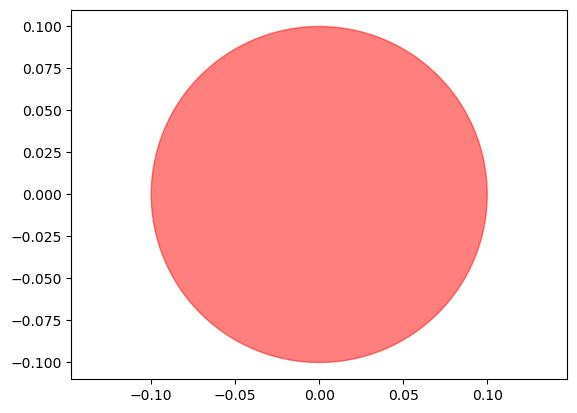
cell.color = 'b'
cell.show()
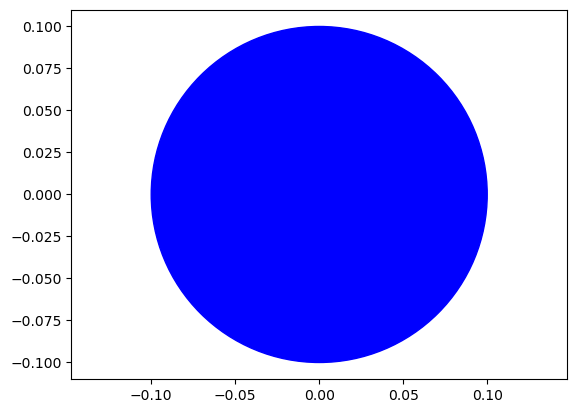
You can create an array of class instances.
n = 10
cells = [Cell(np.random.rand(2),color=np.random.rand(4)) for i in range(n)]
for i in range(n):
cells[i].show()
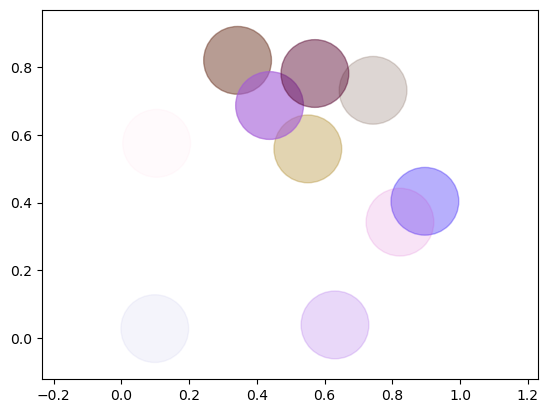
A subclass can inherit attributes and methods of base class.
class gCell(Cell):
"""Class of growing cell based on Cell class"""
def grow(self, scale=2):
"""Grow the area of the cell"""
self.radius *= np.sqrt(scale)
def duplicate(self):
"""Make a copy with a random shift"""
c = gCell(self.position+np.random.randn(2)*self.radius, self.radius, self.color)
return c
c0 = gCell()
c0.show()
c1 = c0.duplicate()
c1.grow()
c1.show()
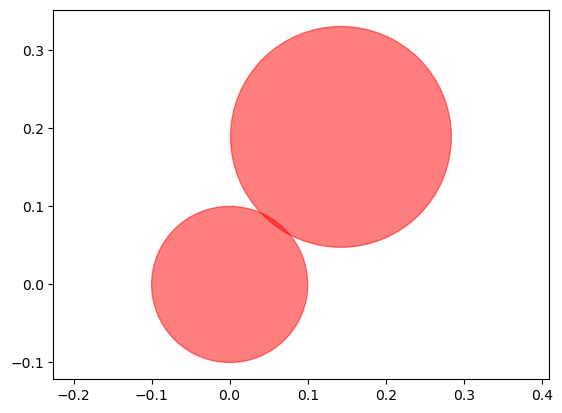
Let us make a new class using gCell class
class Culture():
"""Class for a cell culture"""
def __init__(self, n=10, position=None, radius=0.1, color=None):
"""Make a cell culture with n cells"""
self.number = n # nuber of cells
if position == None: # random position if not specified
position = np.random.rand(n,2)
if color == None: # random colors if not specified
color = np.random.rand(n,4)
self.cells = [gCell(position[i],radius=radius,color=color[i]) for i in range(n)]
def show(self):
"""Visualize as a circules"""
for i in range(self.number):
self.cells[i].show()
def grow(self, scale=2):
"""Grow the area of each cell"""
for i in range(self.number):
self.cells[i].grow(scale)
def duplicate(self):
"""Make a copy of each cell"""
for i in range(self.number):
c = self.cells[i].duplicate()
self.cells.append(c)
self.number *= 2
culture = Culture()
culture.cells[0].position
array([0.381837 , 0.07934348])
culture.show()
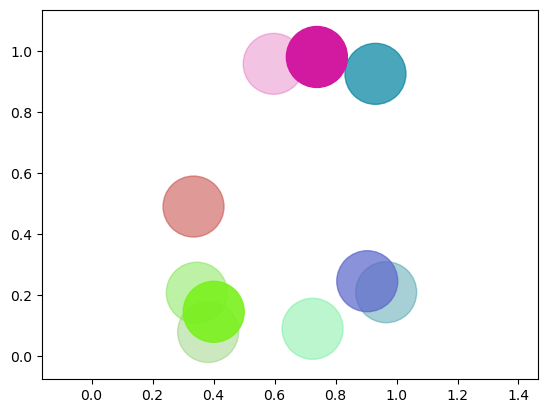
culture.grow()
culture.show()
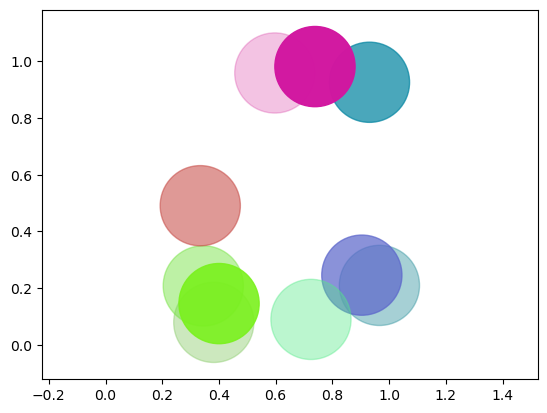
culture.duplicate()
culture.grow(0.5)
culture.show()
